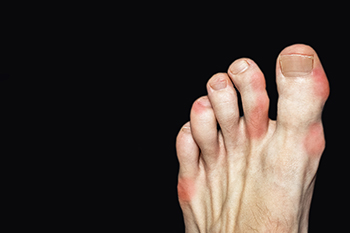
Walking with gout can worsen the condition and lead to increased pain and inflammation. It is not recommended to walk with gout due to the potential damage it can cause to the affected joints.
Gout is a type of inflammatory arthritis that occurs when uric acid crystals accumulate in the joints, most commonly in the big toe. This can lead to severe pain, swelling, redness, and stiffness. Walking or putting pressure on the affected joint can exacerbate these symptoms and potentially cause further damage.
It is crucial to rest the joint and avoid any activities that may strain or worsen the condition. While exercise and physical activity are important for overall health, it is essential for individuals with gout to find low-impact alternatives that do not put stress on the affected joints, such as swimming or stationary biking. Consulting with a healthcare professional or a rheumatologist is advised to determine the most suitable exercise regimen for managing gout.
Should I Walking With Gout?
Gout is a form of arthritis characterized by sudden and severe joint pain. Many people wonder if engaging in exercise can worsen their gout symptoms. While it may seem counterintuitive, regular physical activity can actually be beneficial for individuals with gout. Exercise helps maintain a healthy weight, which is important for managing gout as excess weight can contribute to flare-ups.

Credit: www.cfaspecialists.net
Additionally, staying active improves blood flow and circulation, reducing the risk of crystallized uric acid formation. However, it is essential to approach exercise with caution to prevent triggering gout attacks. Low-impact activities such as walking, swimming, or cycling are generally safe and recommended. It’s crucial to balance exercise intensity and duration and listen to your body. If you experience excessive joint pain or inflammation during or after physical activity, it’s best to consult with your healthcare provider for personalized advice.
Walking With Gout: Benefits And Considerations
Walking can be beneficial for individuals with gout, but it is important to consider certain factors to ensure safety and optimize the benefits. It is essential to consult with a healthcare professional before starting any exercise regimen to determine if walking is suitable for your specific condition.
Is walking beneficial for gout patients?
Walking offers several advantages for patients with gout. It can help maintain a healthy weight, improve joint flexibility, strengthen muscles, and reduce the risk of developing other health conditions such as heart disease and diabetes. Additionally, walking promotes blood circulation and aids in the removal of uric acid crystals, which are responsible for gout symptoms.
Tips for walking with gout safely
| Guidelines | Description |
|---|---|
| 1. Warm up | Prior to walking, perform gentle warm-up exercises to prepare your joints and muscles for physical activity. This can include stretching or light movements. |
| 2. Start slowly | Begin with shorter walking sessions and gradually increase the duration and intensity over time. This allows your body to adjust and reduces the risk of overexertion. |
| 3. Wear appropriate footwear | Choose comfortable shoes with proper cushioning and support to minimize joint impact and enhance stability. |
| 4. Listen to your body | Pay attention to any discomfort or pain during walking. If you experience increased pain or swelling, it may be necessary to modify your activity level or consult a healthcare professional. |
| 5. Stay hydrated | Drink an adequate amount of water before, during, and after your walk to prevent dehydration. |
| 6. Follow a gout-friendly diet | Adopting a diet low in purines, which are found in certain foods, can help minimize the production of uric acid and manage gout symptoms. |
By following these guidelines, individuals with gout can safely incorporate walking into their routine and potentially experience the numerous benefits it has to offer. Remember to always prioritize safety and consult your healthcare professional for personalized advice.
Other Exercise Options For Gout Patients
Exploring alternative exercise options for gout management, especially low-impact exercises, can be beneficial for gout patients. These exercises can help maintain flexibility, strengthen muscles, and improve overall health without putting excessive strain on joints.
Some low-impact exercise options suitable for gout patients include:
| Exercise Types | Benefits |
|---|---|
| Swimming | Provides gentle resistance, full-body workout, and minimal impact on joints. |
| Cycling | Improves cardiovascular health, strengthens leg muscles, and reduces stress on joints. |
| Yoga | Increases flexibility, promotes relaxation, and helps manage stress and pain. |
| Tai Chi | Fosters balance, coordination, and relaxation, enhancing overall well-being. |
These exercises can be incorporated into a regular fitness routine, aiming for at least 30 minutes of moderate exercise on most days of the week. However, it’s crucial to consult with a healthcare professional before starting any new exercise regimen to ensure it aligns with individual needs and limitations.
Creating An Exercise Routine With Gout
Gout can be a debilitating condition, but it doesn’t mean you have to give up on exercise entirely. In fact, incorporating a regular exercise routine into your life can help manage gout symptoms and improve overall health. When designing an exercise plan, it’s essential to consider the unique needs of gout patients.
Stretching exercises can help increase flexibility and reduce joint stiffness. Focus on gentle movements that target the affected joints, such as ankle rolls and knee bends. These exercises can be done daily or as needed to alleviate discomfort.
Strength training exercises are crucial for gout patients. Building muscle strength around affected joints can provide added support and stability. Look for low-impact activities like swimming or using resistance bands to avoid putting excessive strain on the joints.
Remember, before starting any exercise routine, consult with your healthcare provider or a physical therapist who can guide you based on your specific condition. They can also recommend modifications and ensure your exercises align with your gout management plan. With a well-designed exercise routine, you can take control of your gout and enjoy an active lifestyle.
Expert Advice On Exercising With Gout
Gout is a form of arthritis that can cause painful inflammation in the joints, particularly in the feet. While physical activity is important for maintaining overall health, people with gout may wonder if they should continue to exercise. Healthcare professionals recommend that individuals with gout should not avoid exercise altogether, but rather modify their routines to reduce stress on the affected joints.
Insights from healthcare professionals highlight the importance of exercise for managing gout symptoms. Regular physical activity can help reduce the risk of developing gout-related complications, such as obesity, high blood pressure, and cardiovascular diseases. Low-impact exercises like walking, swimming, and cycling are recommended as they exert minimal strain on the joints.
Additionally, it is crucial to start with short duration of exercise and gradually increase intensity and duration over time. This approach allows the body to adjust and minimize the risk of triggering a gout flare-up. Experts also suggest wearing supportive footwear and considering using aids like walking sticks or orthodontic inserts to minimize joint stress during exercise.
In conclusion, individuals with gout should aim to maintain an active lifestyle with appropriate modifications to their exercise routines. By consulting with healthcare professionals and following their recommendations, people with gout can reap the benefits of regular exercise while minimizing the risk of flare-ups and joint damage.
Should I Walk With Gout: FAQ
Does Walking With Gout Make It Worse?
Walking with gout does not necessarily make it worse, but it can cause discomfort and pain. It is important to listen to your body and rest when needed. Gentle exercise, such as walking, can actually help reduce symptoms and improve joint function.

What Is The Best Way To Walk With Gout?
The best way to walk with gout is to take small, regular steps and avoid putting too much pressure on the affected joint. Wearing comfortable, supportive shoes and using walking aids, if necessary, can also help. Additionally, keeping a healthy weight and managing gout symptoms through medication and lifestyle changes is important.
What Stops Gout Pain Immediately?
Immediate relief from gout pain can be achieved by taking over-the-counter pain relievers, such as ibuprofen or naproxen. Applying ice packs and elevating the affected joint can also help reduce pain. Drinking plenty of water and avoiding purine-rich foods can help prevent future gout attacks.
Should I Stay Off My Feet During Gout Attack?
Yes, it is recommended to stay off your feet during a gout attack. Resting can help reduce pain and inflammation in the affected joint. It’s important to elevate the affected area and apply ice to help alleviate symptoms. Consult with your healthcare provider for personalized advice.
Conclusion: Should I Walk With Gout
Walking can be an effective way to manage gout symptoms. By engaging in regular low-impact exercise, individuals with gout can improve joint mobility and reduce inflammation. However, it is important to consult with a healthcare professional before starting any new exercise regimen.
They can provide personalized advice based on your specific needs and medical history. Incorporating walking into your daily routine can help alleviate gout symptoms and promote overall wellness.
